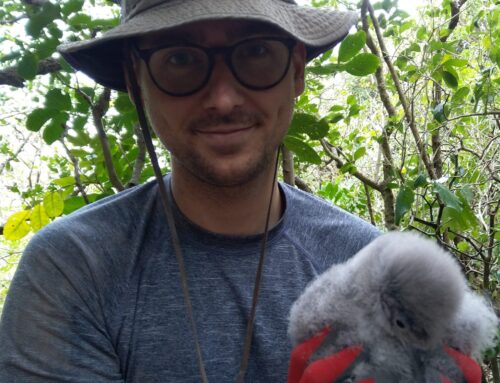
Award-winning oral presentations from the Virtual IBS Early Career Biogeographers Conference
Oskar Hagen, Rohit Chakravarty, and Nina Witteveen
Wednesday, November 24, 2021
Start time: 5 pm Central European Time (4 pm UTC)
Join us on Wednesday, November 24th at 5 pm CET, for talks by Oskar Hagen (‘Best Oral Presentation’ Winner; sponsored by PeerJ), Rohit Chakravarty and Nina Witteveen (both ‘Honourary Mention Oral Presentation’; sponsored by the IBS) from our Early Career Biogeography Conference (ECBC) of last October 2021.
Oskar Hagen and Rohit Chakravarty will be available for Q&A after their talks.
Abstracts:
- Oskar Hagen: Deep-time environmental dynamics coupled with eco-evolutionary processes explains the uneven biodiversity across tropical moist forests – Best Oral Presentation Winner
The biodiversity found across tropical moist forests, the most species-rich terrestrial biome on the planet, varies broadly between the high diversity of the Neotropics and Indomalaya and the relatively lower diversity of the Afrotropics. Explanations for this variation across different regions, the “pantropicaldiversity disparity” (PDD), remain contested, due to difficulty teasing apart the effects of contemporary climate and paleoenvironmental history. Here, we assess the universality of the PDD across more than 150,000 species of terrestrial plants and vertebrates and investigate the relationship between the present-day climate and patterns of species richness. We then investigate the consequences of paleoenvironmental dynamics on the emergence of biodiversity using a novel spatially explicit model of diversification (gen3sis) coupled with a paleoenvironmental re-construction of plate tectonics, temperature and aridity. While contemporary climate is insufficient in explaining the PDD; a simple model of diversification coupled with paleoenvironmental constraints is successful in reproducing the variation in species richness and phylogenetic diversity seen repeatedly among plant and animal taxa, suggesting a prevalent role of paleoenvironmental dynamics. Our model indicates that high biodiversity in Neotropical and Indomalayan moist forests is driven by complex macroevolutionary dynamics associated with mountain uplift. Lower diversity in Afrotropical forests is associated with lower speciation rates and higher extinction rates driven by sustained aridification over the Cenozoic. Our analyses provide a mechanistic understanding of the emergence of uneven diversity in tropical moist forests across 110 Ma of Earth’s history, highlighting the importance of deep-time paleoenvironmental legacies in shaping biodiversity patterns.
- Rohit Chakravarty: Functional diversity of Himalayan bat communities declines without the loss of phylogenetic diversity at high elevation
Species richness exhibits well-known patterns across elevational gradients in various taxa. However, species richness represents only one aspect of quantifying biodiversity patterns. Functional and phylogenetic diversity, although they provide mechanistic insights into the structuring of communities, have received much less attention, particularly for vertebrate taxa. There is still a limited understanding of how functional, phylogenetic and taxonomic diversity change in concert across large gradients of elevation. Here, we focused on the Himalaya—representing the largest elevational gradients in the world—to investigate the patterns of taxonomic, functional, and phylogenetic diversity in a bat assemblage. Combining field data on species occurrence and functional traits with measures of phylogenetic diversity, we found that bat species richness and functional diversity declined at high elevation but phylogenetic diversity remained unchanged. At the lowest elevation, we observed low functional dispersion despite high species and functional richness, suggesting a niche packing mechanism. The decline in functional richness, dispersion, and divergence at the highest elevation is consistent with patterns observed due to environmental filtering. These patterns are driven by the absence of rhinolophid bats, four congeners with extreme trait values, at high elevations. Our functional trait data, some of the first on mammals from the Himalayan region, suggest that bat assemblages with relatively high species diversity may be functionally and phylogenetically redundant.
- Nina Witteveen: 30,000 years of landscape and vegetation dynamics in a mid-elevation Andean valley
The mid-elevation Andean flanks are important biodiversity hotspots, yet little is known of their long-term ecology or environmental change. This study investigated 30,000 years of vegetation dynamics on a historic floodplain in a mid-elevation Andean forest in the Northern Andes (Campo Libre, Ecuador). Loss-on-ignition and particle size analysis were used to reconstruct past river dynamics, charcoal analysis to reconstruct past fire regimes and phytolith analysis to reconstruct vegetation through time. The results showed Campo Libre was part of the floodplain system of the Quijos River until 18,000 cal yr BP. After river incision left the floodplain inactive, Campo Libre transformed into a swampy marsh. CONISS and DCA analyses indicated that major ecological changes occurred at the onset of the Holocene (ca. 13,000 cal yr BP), when the site warmed and dried, transforming the swamp into a palm forest. Increasing levels of precipitation transformed the site back into a swamp around 7500 cal yr BP. It remained that way until maize agriculture began around 4600 cal yr BP. Local and regional fires were absent from the system until regional fires were detected ca. 3300 cal yr BP. Maize cultivation became frequent and regular by ca. 2700 cal yr BP. Ecological changes associated with maize agriculture were smaller than the ecological responses to climatic changes. Overall, these results demonstrate the ability of phytoliths to reconstruct vegetation change through time. These results also show that the mid-elevation Andean valley systems were highly dynamic, and highly responsive to climatic changes in the Pleistocene and Holocene.






